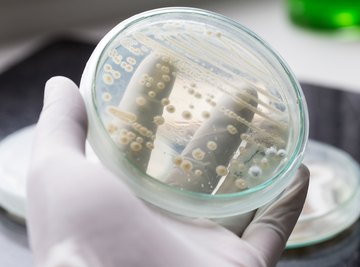
Living things can be divided into prokaryotes, which appeared about 3.5 billion years ago and are the most ancient organisms on Earth, and eukaryotes, the origins of which took root about half a billion years later. Prokaryotes include the domains Bacteria and Archaea and consist almost entirely of single-celled organisms with low complexity and a limited number of internal components.
The domain Eukaryota – animals, plants and fungi – are almost all multicellular and boast a variety of specialized organelles and other sophisticated features.
As befits their minimalist existence, prokaryotic cells reproduce by simply dividing in half in a process called binary fission to form identical daughter cells, with comparatively little of unique interest occurring between divisions. Eukaryotes, in contrast, proceed though a number of distinct stages between cell divisions. Together, these stages make up the cell cycle.
The Purpose of the Cell Cycle
If you were standing in a field where a recent snowfall had occurred and your job was merely to make snowballs and toss them at a nearby target, you wouldn't have to think too much about this task. You could just pick up a handful of snow, pack it into a roughly spherical shape and let it fly.
If your job, however, was to make snowmen or snow-women with distinct features such as arms and noses, you would have to arrange your work into specialized tasks and do them in a certain order. You could not, for example, put a top hat on your creation until you had installed its head; your product would be either visibly flawed or unrecognizable without thought and planning.
So it is in the cellular world. Unlike prokaryotic cells, eukaryotic cells cannot simply divide more or less unchecked and with no biochemical oversight. An exquisite level of coordination is needed to ensure that all goes well.
Cell growth, replication of DNA (the cell's genetic material), the even separation of the duplicated DNA in the form of chromosomes to daughter cells and cell division all must take place in the right order and using the correct elements to prevent unwanted outcomes, some of which could kill the parent organism.
Overview of the Cell Cycle Phases
A cell cycle diagram is the most helpful way to appreciate the relationships between the names, events and duration of each of the stages and substages (or if you prefer, phases and subphases). The key points of the cell cycle, however, are easy enough to sum up using simple descriptions.
Interphase refers to the various periods during which the cell is preparing to divide, and includes the G1 (first gap), S (synthesis) and G2 (second gap) phases.
The M phase, which is synonymous with mitosis, refers to the phases in which the nucleus of the cell divides into daughter nuclei, and includes prophase, metaphase, anaphase and telophase, with some sources choosing to define the transition between prophase and metaphase as its own subphase, named prometaphase.
The physical division of the entire cell, called cytokinesis, occurs right after mitosis and is generally considered to be the final phase of any cell cycle.
Interphase: G1
At the start of the G1 phase, each cell is the equivalent of a newborn infant. Most cells, however, exist only about a day or even just a matter of hour rather than years. In G1, the cell enlarges, but the DNA in the nucleus is left alone with all of the other components – i.e., the cytoplasm and the organelles – increasing in mass as a result of protein synthesis.
This phase has no direct bearing on the genetic outcomes of subsequent cell generations, but from a practical standpoint, if a cell (or anything) is to eventually divide into two equally sized objects, it needs to become about twice as big before this happens.
This phase normally takes a little less than half of the total cell cycle time to complete.
Interphase: S
With everything outside the nucleus more or less taken care of, the cell in S phase now dives into the job of replicating, or copying, its chromosomes. In humans, this means replicating 46 individual chromosomes, 23 from each parent.
These are not necessarily physically associated with each other in cell nuclei except in meiosis; they are just distinctly similar and paired entities, like gloves, socks, shoes and earrings thrown haphazardly into a box.
When all 46 chromosomes have been replicated, each of these now exists as an identical twin set, each member being a sister chromatid to its partner. These are joined along their length (not usually in the middle) at a structure called the centromere.
This phase is normally shorter than either G phase, consuming perhaps a third of the total cell cycle.
Interphase: G2
In theory, the cell is now almost ready to divide. In order to get ready for this, the cell needs specialized structures that permit the process of mitosis itself, and this is managed in G2, which takes about as long as G1 (usually, somewhat less time).
For example, microtubules, which form the cytoskeleton that provided scaffolding for the cell as a whole, are "borrowed" from the cytoskeleton to assemble the mitotic spindle, which is required to physically separate chromosomes during mitosis.
Also, although errors in cell growth and replication are statistically rare in relation to the staggering number of times cell division occurs each day in a multicellular eukaryote, a great deal can go awry in the G1 and S phases of the cell cycle. One of the tasks of the G2 cell stage is to ensure that this has not happened and to correct any errors uncovered by the cell's version of detectives.
The M Phase and Cytokinesis
In a cell with a cycle lasting a total of a day, the M phase might last only an hour or so, but an eventful hour it is. Describing mitosis in detail is a task that needs its own article or book chapter, but to sum up this elegant biochemical symphony:
- Prophase is when the duplicated chromosomes condense into forms recognizable under a powerful microscope, and the mitotic spindle starts to form. Prophase consumes about half of mitosis.
- Prometaphase is when the jumble of chromosomes begin a pilgrimage to the center of the cell, without which division would be pointless or grossly incorrect.
- Metaphase sees the migrated chromosomes line up "perfectly" along the axis of division along a line passing through all 46 centromeres, with one sister chromatid in each pair on either side.
- Anaphase is when the chromosomes are actually pulled apart. It is what probably comes to mind when you imagine a cell dividing in two.
- Telophase is when the nuclear membrane forms around the new daughter nuclei, and the chromosomes revert to their more diffuse form in the nuclei.
Cytokinesis is simply the splitting of the cell as a whole, distinct from the separation if the nucleus but contingent on the successful completion of mitosis. If regarded as a phase of the cell cycle, it is by far the shortest one.
Mitosis vs. Meiosis
Meiosis is a form of cell division that takes place only in eukaryotes and is essential for sexual reproduction. It produces cells called gametes (sex cells) – sperm in males and eggs in females.
These cells are produced only in specialized cells in the gonads (testes in males, ovaries in females) and is not considered a part of the "normal" cell cycle.
References
About the Author
Kevin Beck holds a bachelor's degree in physics with minors in math and chemistry from the University of Vermont. Formerly with ScienceBlogs.com and the editor of "Run Strong," he has written for Runner's World, Men's Fitness, Competitor, and a variety of other publications. More about Kevin and links to his professional work can be found at www.kemibe.com.
